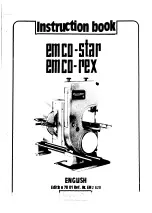
GENERAL SAFETY RULES FOR POWER TOOLS
WARNING: When using electric tools the following basic safety precautions should always be
followed to reduce the risk of fire, electric shock and personal injury.
PLEASE READ ALL THESE INSTRUCTIONS BEFORE ATTEMPTING TO OPERATE THIS PRODUCT.
1. KEEP GUARDS IN PLACE, and in working order.
2. REMOVE ADJUSTING KEYS AND WRENCHES. Form habit of checking to see that keys and adjusting wrenches are
removed from tool before turning it on.
3. KEEP WORK AREA CLEAN. Cluttered areas and benches invite accidents.
4. DON'T USE IN DANGEROUS ENVIRONMENT. Do not use power tools in damp or wet location, or expose them to
rain. Do not operate them in an area with flammable liquids or gases. Keep work area well lighted.
5. KEEP CHILDREN AWAY. All visitors should be kept at a safe distance from work area.
6. MAKE WORKSHOP CHILD PROOF. Lock access of your workshop. When not in use, tools should be stored in a dry
locked up place, out of reach of children.
7. DON'T FORCE TOOL. It will do the job better and safer at the rate for which it was designed.
8. USE RIGHT TOOL. Don't force tool or attachment to do a job for which it was not designed.
9. USE PROPER EXTENSION CORD. Make sure your extension cord is in good condition. When using an extension
cord, be sure to use one heavy enough to carry the current your product will draw. An undersize cord will cause a drop
in line voltage resulting in loss of power and overheating.
10. WEAR PROPER APPAREL. Do not wear loose clothing, gloves, neckties, rings, bracelet, or others jewellery which
may get caught in moving parts. Nonslip footwear is recommended. Wear protective hair covering to contain long hair.
Roll long sleeves above elbows.
11. ALWAYS USE SAFETY GOGGLES. Everyday glasses only have impact resistant lenses, they are NOT safety
glasses. Also use face or dust mask if cutting operation is dusty.
12. SECURE WORK. Use clamps or a vice to hold work when practical. It is safer than using your hand and it frees both
hands to operate tool.
13. DON'T OVERREACH. Keep proper footing and balance at all times.
14. MAINTAIN TOOL WITH CARE. Keep tool sharp and clean for best and safest performance. Follow instructions for
lubrication and changing accessories.
15. DISCONNECT TOOLS before servicing: when changing accessories, such as blades, bits, cutters and the like.
16. USE RECOMMENDED ACCESSORIES. Consult the owner's manual for recommended accessories. The use of
improper accessories may cause risk of injury to persons.
17. NEVER STAND ON TOOL. Serious injury could occur if the tool is tipped or if cutting tool is unintentionally contacted.
18. CHECK DAMAGED PARTS. Should any part of the tool be missing, damaged or any electrical component fails to
perform properly, tum off the power and remove plug from power supply. Properly repair or replace damaged, missing
and/or failed parts before resuming operation.
19. DIRECTION OF FEED. Feed work into a blade or cutter against the direction of rotation of the blade or cutter only.
20. NEVER LEAVE TOOL RUNNING UNATTENTED. TURN POWER OFF. Don't leave tool until it comes to a complete
stop.
21. DO NOT ABUSE THE CORD. Do not use cord to disconnect during operation. Never yank the cord to disconnect it
from the socket.
22. ALWAYS KEEP ALERT. Do not let familiarity gained from frequent use of your tool cause a careless mistake. Always
remember that a careless fraction of a second is sufficient to inflict severe injury.
23. THINK SAFETY. Safety is a combination of common sense and alertness whenever the tool is in operation.
24. DRUGS, ALCOHOL, MEDICATION. Do not operate tool while under the influence of drugs. alcohol or any
medication.
25. MAKE SURE TOOL IS DISCONNECTED FROM POWER SUPPLY while motor is being mounted, connected
or reconnected.
26. WARNING: The dust generated by certain woods and wood products can be injurious to your health. Always
operate machinery in well ventilated areas and provide for proper dust removal. Use wood dust collection
systems whenever possible.
































